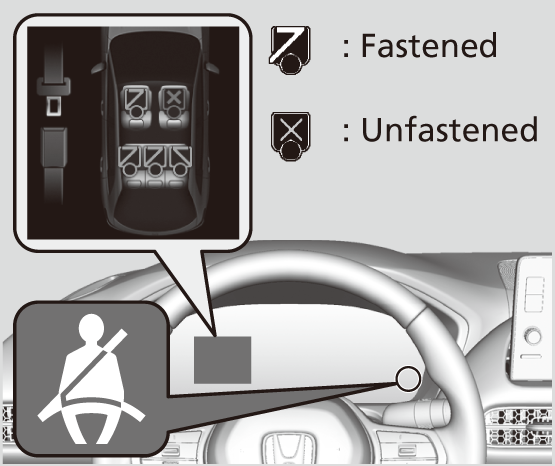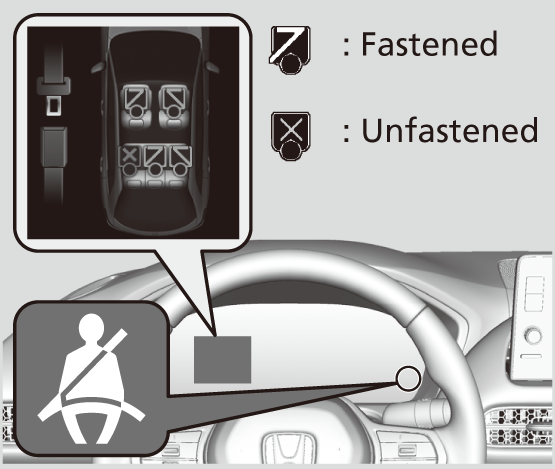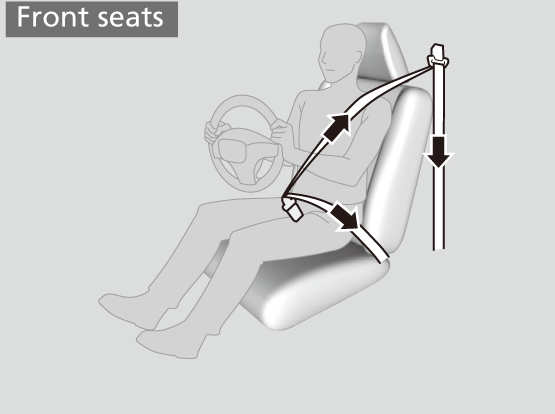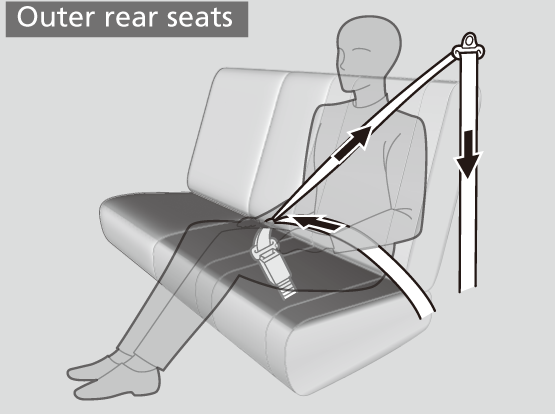About Your Seat Belts
Seat belts are the single most effective safety device because they keep you connected to the vehicle so that you can take advantage of many built-in safety features. They also help keep you from being thrown against the inside of the vehicle, against any passengers, or out of the vehicle. When worn properly, seat belts also keep your body properly positioned in a crash so that you can take full advantage of the additional protection provided by the airbags.
In addition, seat belts help protect you in almost every type of crash, including:
- frontal impacts
- side impacts
- rear impacts
- rollovers
- WARNING
-
Not wearing a seat belt properly increases the chance of serious injury or death in a crash, even though your vehicle has airbags.
Be sure you and your passengers always wear seat belts and wear them properly.
- Detail
-
If you extend the seat belt too quickly, it will lock in place. If this happens, slightly retract the seat belt, then extend it slowly.Seat belts cannot completely protect you in every crash. But in most cases, seat belts can reduce your risk of serious injury.Most states and all Canadian provinces and territories require you to wear seat belts.If a rear seat passenger moves around and extends the seat belt, the lockable retractor may activate. If this happens, release the retractor by unfastening the seat belt and allow the belt to retract completely. Then, refasten the belt.
Lap/shoulder seat belts
All five seating positions are equipped with lap/shoulder seat belts with emergency locking retractors. In normal driving, the retractor lets you move freely while keeping some tension on the belt. During a collision or sudden stop, the retractor locks to restrain your body.
The front passenger’s and rear seat belts also have a lockable retractor for use with child seats.
Installing a Child Seat with a Lap/Shoulder Seat Belt
Proper use of seat belts
Follow these guidelines for proper use:
- All occupants should sit upright, well back in the seat, and remain in that position for the duration of the trip. Slouching and leaning reduce the effectiveness of the belt and can increase the chance of serious injury in a crash.
- Never place the shoulder part of a lap/shoulder seat belt under your arm or behind your back. This could cause very serious injuries in a crash.
- Two people should never use the same seat belt. If they do, they could be very seriously injured in a crash.
- Do not put any accessories on the seat belts. Devices intended to improve comfort or reposition the shoulder part of a seat belt can reduce the protective capability and increase the chance of serious injury in a crash.
Seat Belt Reminder
-
Front seats
The seat belt system includes an indicator on the instrument panel to remind the driver or a front passenger or both to fasten their seat belts.
If you set the power mode to ON and a seat belt is not fastened, a beeper will sound, and the indicator will blink. After a few seconds, the beeper will stop and the indicator will come on and remain illuminated until the seat belt is fastened.The beeper will periodically sound and the indicator will blink while the vehicle is moving until the seat belt is fastened.
-

-
Rear seats
Your vehicle monitors rear seat belt use.
The driver information interface notifies you if any of the rear seat belts are unfastened after they were previously fastened.In order to encourage the driver to evaluate rear seat belt usage, the display appears when:
- Any of the rear passenger seat belts are unfastened when the power mode is set to ON.
- A rear door is opened and then closed.
- Any of the rear passengers fasten or unfasten their seat belt.
The seat belt reminder indicator blinks and the beeper sounds if any rear passenger seat belts are unfastened while driving.
To see the display:
-

- Detail
-
The indicator will also come on if a front passenger does not fasten their seat belt within six seconds after the power mode is set to ON.
When no one is sitting in the front passenger’s seat, the indicator will not come on and the beeper will not sound.The indicator also may not come on, and the beeper may not sound when the occupant is not heavy enough to trigger the weight sensor. Such occupants (e.g., infants and smaller children) should be moved to the rear seat as a deploying front airbag likely will injure or kill them.
The driver information interface uses colors to aid the driver in checking the status of the passengers.
For the front seating positions:- Green indicates the seat belt is fastened.
- An unfastened gray graphic indicates the seat belt is not fastened, and an occupant has not been detected.
- An unfastened red graphic indicates the seat belt is unfastened, and an occupant has been detected.
The system will not detect a passenger in the rear seats who has not fastened the seat belt.
The driver should check the status of the rear passengers’ seat belts at the start of each trip and each time a passenger is seated in the rear seats, using the driver information interface as an aid.
An alert will sound if a passenger in the rear seats unfastens the seat belt while the vehicle is in motion or if motion resumes while the graphic is red.The driver information interface uses colors to aid the driver in checking the status of the passengers.
For the rear seating positions:- Green indicates the seat belt is fastened.
- An unfastened gray graphic indicates the seat belt has not been fastened recently.
- An unfastened red graphic indicates the seat belt was unfastened recently.
The system does not monitor harnesses that are part of a child seat, nor the anchors of the LATCH system.
While the system can inform you that a seat belt is fastened, it cannot determine whether a child seat is properly installed or used.
Automatic Seat Belt Tensioners
The front seats and the outer rear seats are equipped with automatic seat belt tensioners to enhance safety.
The tensioners automatically tighten the front seat belts and the outer rear seat belts during a moderate-to-severe frontal collision, sometimes even if the collision is not severe enough to inflate the front airbags or the front knee airbags.
- Detail
-
The seat belt tensioners can only operate once.
If a tensioner is activated, the SRS indicator will come on. Have a dealer replace the tensioner and thoroughly inspect the seat belt system as it may not offer protection in a subsequent crash.During a moderate-to-severe side impact, the tensioners on both sides of the vehicle also activate.
- Recommended topic(s)



